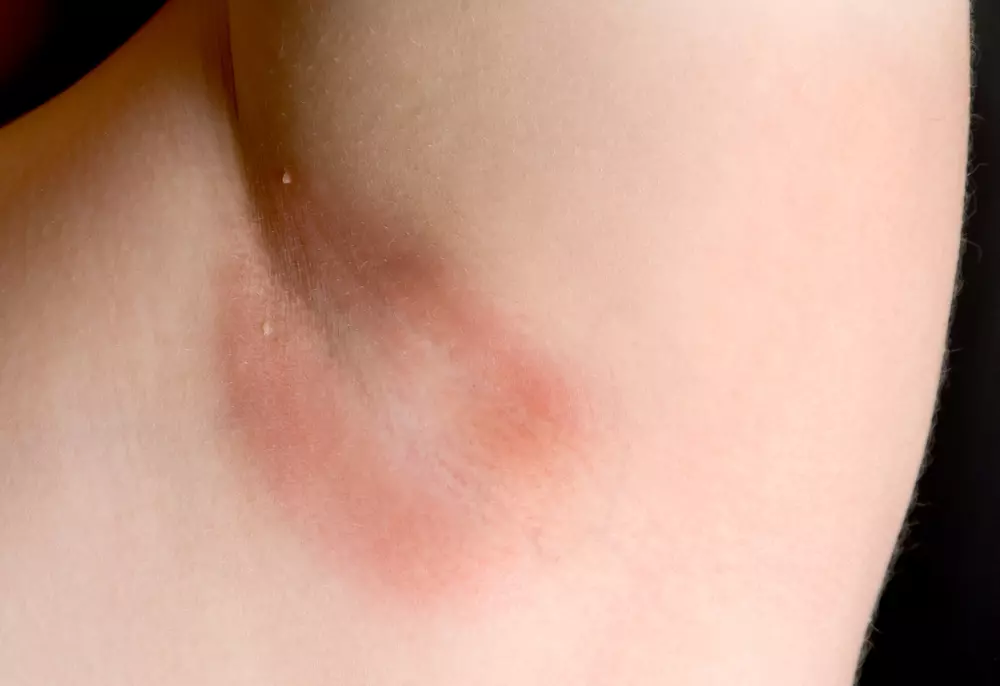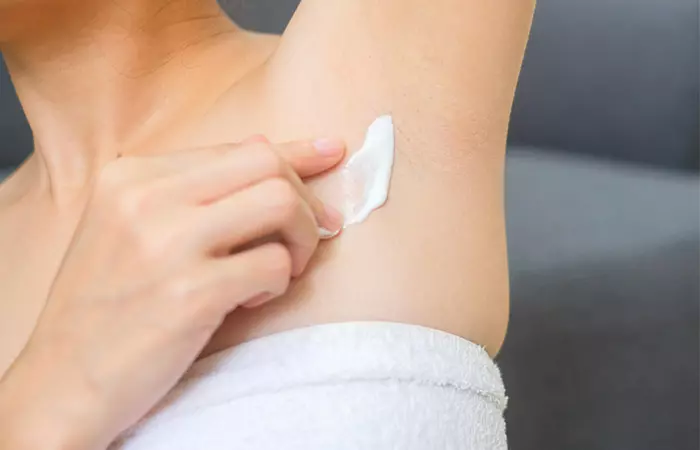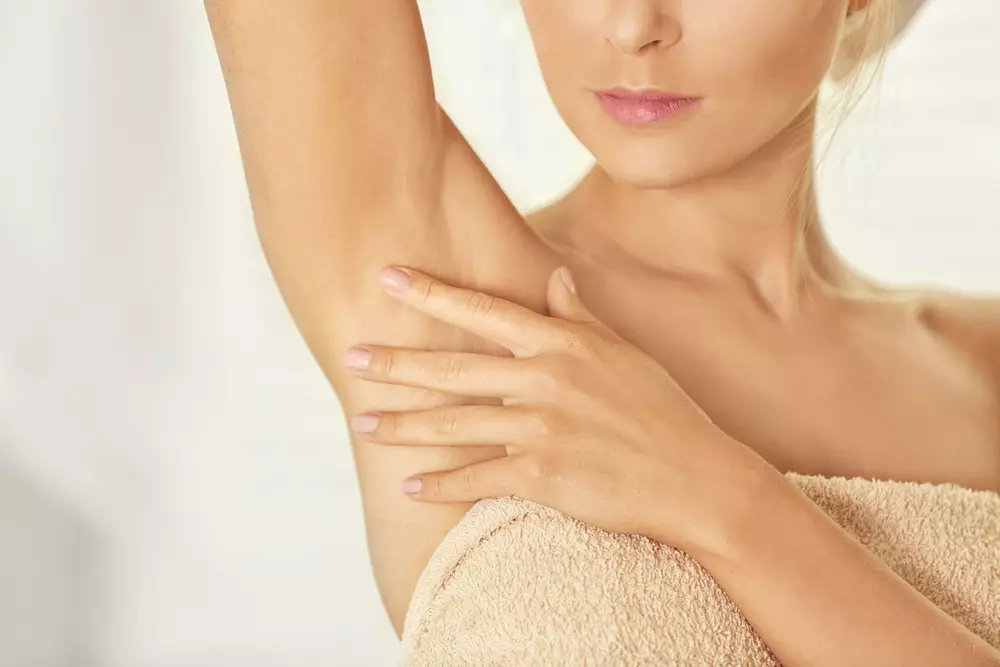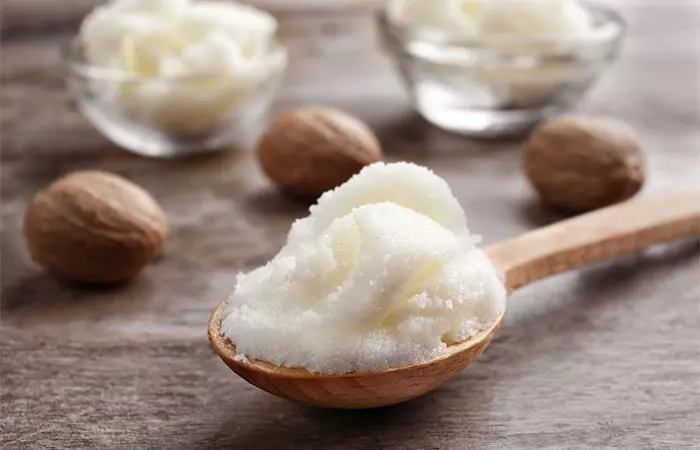You can use professional treatments and home remedies to get rid of them. This article discusses different tips and home remedies to treat armpit rashes and prevent them. Keep scrolling!
Armpit Rashes: Types And Causes
If your armpits are itchy and appear reddish for hours or days, you may have a rash. It could be caused by an allergic reaction (to deodorant chemicals or others) or an underlying infection. Sometimes, even the skin surfaces around your armpits rubbing against each other can cause the rash. Armpit rashes are of different types.
1. Chafing
This is the rash that occurs wherever you have skin folds, including the armpits. It is caused as a result of the skin rubbing against itself. Chafing is characterized by the following signs:
Redness Stinging and burning sensation Swelling (in severe cases, skin may crack and bleed) The top layer of the skin appears rubbed off.
This is more common in summers or when you wear tight clothes.
2. Atopic Dermatitis (Eczema)
This is a chronic condition in which your skin is inflamed. It occurs mostly in the skin folds, including the armpits, areas behind the knees, and inner elbows (where the skin folds). The signs include:
Redness Itchiness Crusting Bleeding (only if it is severe) Oozing fluid when scratched
Eczema can also cause flare-ups several times during the year, and the rashes may last for a week or more if untreated. A blogger shared her experience managing eczema. She first found out she had eczema in 2012 but her condition was minimal. She writes, “…but I had a few patchy rashes in specific places: around my eyes, on the side of my face, and on my neck (i).” However, her rashes kept getting worse. Talking about her most recent rash she adds, “The neck rash that developed very soon after starting the candida diet, and stopping topical steroids. It looks like two very large red angry hands wrapped themselves around my neck…There’s a very clearly outlined rashy patch on my cheek.” The following graph displays data on the proportion of adults with eczema who said certain symptoms were the most bothersome. The result of the poll by people with eczema, those who care for people with eczema, and their spouses, partners, or family members revealed that itching was the most troublesome symptom of the condition, while anxiety and depression were considered as the least problematic symptoms.
Most Problematic Eczema-Related Symptoms Worldwide
3. Allergic Contact Dermatitis
This is your skin reacting to antiperspirantsi Products that reduce sweat or perspiration on the skin and lessen body odor by blocking the sweat glands. or deodorants or other external allergens. The chemicals may irritate your armpits, causing redness, itchiness, small bumps, and a stinging sensation. In severe cases, you may even get blisters.
4. Seborrheic Dermatitis
This is when the excess sebum your skin produces causes patches and rashes. These usually appear oily and flaky. These rashes are more common in infants and can appear in their armpits, ears, scalp, or the face.
5. Candida
Candida is a skin infection that is most commonly caused by Candida albicans, a species of yeast. These breed in moist and warm parts of your body, including the armpits. A study was conducted by The Centers for Disease Control and Prevention (CDC) across 45 countries in 9 states consisting of approximately 17 million people. They identified 1226 candidemia cases across the 9 states. It was estimated that there were about 22,660 candidemia cases in the US in 2017. A sweat gland infection can lead to skin irritation and inflammation, often resulting in an underarm rash. The signs of candida include:
Itching Scaling Swelling Redness and rashes
Tight clothes, hot/humid weather, or poor skin hygiene can be the contributing factors. Certain steroid creams can also exacerbate the infection.
6. Tinea Corporis (Ringworm)
Tinea corporis is a fungal infection affecting the topmost layer of your skin, causing a red rash with raised borders.
7. Erythrasma
Erythrasma is caused by bacteria called Corynebacterium minutissimum. It can affect your armpits, the groin area, and the area under your breasts. The rash looks reddish and is accompanied by a change in the skin texture. Usually, doctors treat this rash with fusidic acid or clindamycin. The skin folds are the most common spots for an infection. But these are treatable with dermatological medications and some mild cases with effective home remedies.
Tips To Treat Armpit Rashes
When you spot a rash, visit the dermatologist first and understand the type of infection you have. The doctor may suggest medications and topical ointments (based on the type of rashes) like:
Hydrocortisone creams (0.5-1.0%) Antihistamine medications OTC calamine lotions and creams Antifungal gels, creams, lotions, and spray Antibacterial cream
If your armpit rash is a result of a chronic condition, like eczema, the doctor may suggest certain prescription medications including:
Mild steroid creams Phototherapyi A treatment that uses a specific type of UV light to reduce the inflammation associated with chronic eczema and psoriasis. PDE4 inhibitorsi A type of medication that reduces the inflammation associated with skin conditions like eczema and psoriasis.
Apart from these medications, you may also try certain home remedies for relief. Do keep in mind that these remedies do not have direct scientific research backing them up. We do not have enough studies to prove their effectiveness in treating armpit rashes.
Potential Home Remedies To Treat Armpit Rashes
1. Virgin Coconut Oil
Virgin coconut oil has a soothing and moisturizing effect on the skin and is said to improve symptoms of skin disorders (1). Massage a few drops of the oil on the affected area. Leave it on for at least 30 minutes and then wash with lukewarm water.
2. Topical Vitamin B12
Topical Vitamin B12 cream was found to help reduce the severity of atopic dermatitis (2). Though it is not known if it can have similar therapeutic effects on armpit rashes, it can be worth a try. Remember to check with your doctor, though.
3. Ice Cubes
Placing ice cubes on the skin can have a numbing effect. You can also relieve itchy rashes by applying ice cubes to them. The resultant relief can also keep you from scratching the rashes and aggravating them.
4. Citrus Extracts
Citrus extracts or pomace (whatever remains after pressing and extracting the juice and pulp) are shown to have antibacterial and antimicrobial activities (3). You may apply citrus (orange or lemon or any citrus fruit) juice or extracts on the affected area. To use citrus extract, extract the pulp or juice of any citrus fruit and mix it with water. Apply to the affected area. You may rub the leftover pulp on the affected area. Leave it on for a few minutes and then wash with plain water.
5. Apple Cider Vinegar
People usually use apple cider vinegar on the skin for its pore-tightening and skin-soothing effects. You may use it to soothe itchy and irritating armpit rashes as well. Dilute a tablespoon of ACV in half a cup of water. Use a cotton ball to apply the mixture to the rash. Leave it on for at least 30 minutes and then wash with plain water. There is another great armpit detox recipe using ACV. Mix 1 tablespoon of apple cider vinegar with 1 tablespoon of bentonite clay. Pour 2-3 drops of tea tree or coconut oil into the mixture. Apply the paste to your armpit and allow it to sit for 5-10 minutes. Rinse the area with warm water and let it air dry.
6. Sunflower Oil
According to the National Eczema Association, sunflower oil can help treat eczema by improving the skin barrier and reducing inflammation (4). You may try using sunflower oil for soothing and calming your armpit rash. Take a few drops of the oil and gently massage on the affected area. Leave it on for 15-30 minutes and then wash with plain water.
7. Shea Butter
Shea butter is known for its moisturizing ability. It soothes flakiness and itchiness and calms your skin. You may apply shea butter to on the affected area for relief. Massage a little of the butter on the affected area. You can leave it on for 30 minutes and then wash with plain water.
8. Tea Tree Oil
Tea tree oil has antimicrobial and antiseptic properties (5). It can help soothe your rash and reduce irritation. Mix 10 drops of tea tree oil with two tablespoons of coconut oil. Massage the mixture gently on the affected area. Leave it on for 15-30 minutes and then wash with plain water.
9. Chamomile Tea Bag
Chamomile tea bags feel soothing on the skin. They can help minimize itching and irritation. Boil the tea bags in water for a few minutes. Leave them to cool down a bit. Apply the cold tea bags to the affected area as a compress.
10. Lavender Oil
Lavender oil has potent antioxidant, antimicrobial, and anti-inflammatory properties and is used in treating eczema and dermatitis (6). This suggests that it may help relieve the inflammation caused by armpit rashes. Mix 2-3 drops of lavender oil with 1 tablespoon of any carrier oil (coconut, castor, jojoba, etc.). Dampen the affected areas and apply the oil blend.
11. Oatmeal
Oatmeal has anti-inflammatory, calming, and wound-healing properties (7). Taking an oatmeal bath or applying its paste may soothe irritation and help soothe the rashes. Mix equal parts of powdered oatmeal and water to form a paste. Apply it to the affected areas, let it dry, and then gently wash it off with warm water. Follow it up with a soothing moisturizer. You don’t have to take all this trouble if you know how to prevent armpit rashes in the first place. Let’s now take a look at the preventive measures.
Preventing Armpit Rashes
1. Practice Good Hygiene
Take a bath regularly using a mild shower gel. After bathing, dry yourself thoroughly. Even if you are using a towel, try to air dry the body folds before you dress up.
2. Know What Irritates Your Skin
It can be a particular deodorant or a roll-on antiperspirant or any other personal care product. If you notice that a specific product or ingredient (such as products containing alcohol) is giving you rashes, stop using it right away.
3. Avoid Tight Clothes
Wearing tight clothes made of synthetic fabric may often cause armpit rashes. Such clothes cannot allow sweat to escape, making it accumulate in the armpits. Wear soft fabrics made of cotton. They let your skin and armpits breathe.
4. Use Anti-Chafing Powder
The rashes you develop in your armpits are more often just heat rashes. They occur when the weather is hot and humid. Applying anti-chafing powder to your armpits keeps your skin from rubbing against itself. You can also try staying in a cool, air-conditioned place more often. Proper care can keep rashes from worsening and also prevent them. If not, they may develop into a chronic rash. Please visit your doctor if you experience the following:
Rashes accompanied by high fever Blisters on the affected area Rashes spreading to other parts of the body Swelling and pain in the affected area Rashes that ooze pus, blood, and fluid Rashes that do not respond to home remedies and OTC medicines Rashes that are tender, swollen, and red Rashes accompanied by vomiting, nausea, and dizziness
Does armpit rash go away on its own? Some cases of armpit rash may go away on their own, such as rashes caused due to chafing. However, in some other cases, treatment may be necessary to get rid of it. Can stress cause armpit rash? Stress may trigger a flare-up in individuals with eczema, leading to armpit rashes. Does Vaseline help armpit rash? Yes, Vaseline may help reduce the itching or discomfort associated with an armpit rash. Learn how to treat armpit yeast infection at home with simple and natural remedies. Click on the video below to relieve itchiness and discomfort quickly and easily!












